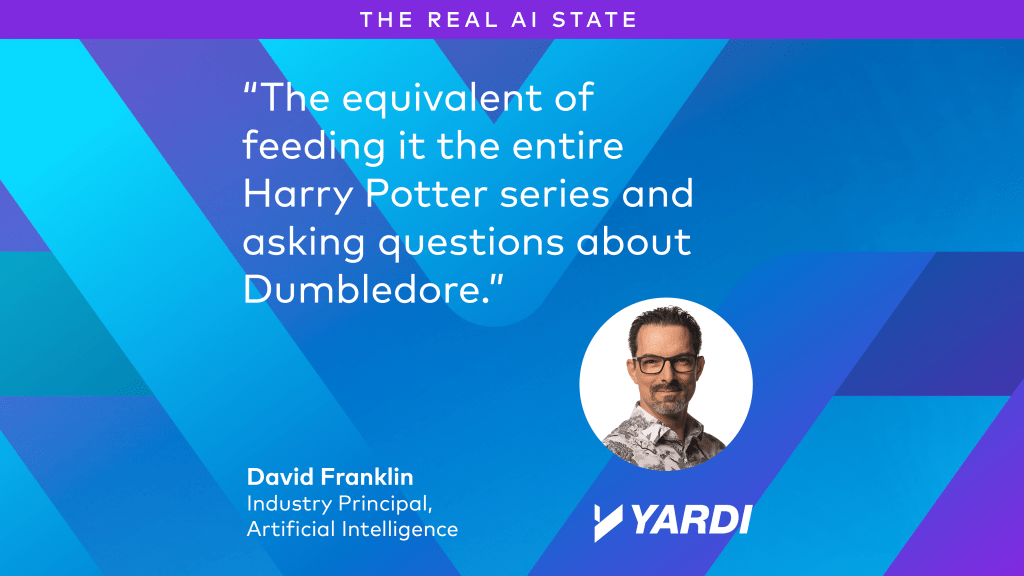By David Franklin on May 16, 2025 in Technology

This week has been exciting from the perspective of Yardi, as there was an incredible update to our AI strategy from our president, Akshai Rao. In addition to announcing our Composer framework, it was made clear that we are aligning our strategy with what we’re seeing from other top-tier software providers like Salesforce. Additionally, there was a big announcement from OpenAI (ChatGPT 4.1 has been released), Grok from X.ai went a bit crazy and Alibaba released an open-source AI video tool called Wan 2.1.
Let’s dig in!
Yardi
What Happened
Brian Sutherland and Akshai Rao announced a refined AI strategy for Yardi as it relates to our product line and how we build AI applications for our clients. Central to this shift is the idea that AI will be powered by “Agents,” where specific tasks will be delegated to different AIs, each configured to be an expert in its respective field. This leads us to the idea that organizations will need to start thinking about what their “AI Org Chart” will look like and how their AI agents will be able to connect into other systems.
We will be developing Composer, a toolset for building these agents as well as an Agent Marketplace where Yardi, third-party consultants and clients will all be able to create and utilize these agents to solve specific tasks.
Why it matters
Traditionally, Yardi has been focused on building everything our clients need into our software. With the advent of agentic AI, it now makes sense to work with our clients and third parties to develop new, AI-powered solutions. This is a new concept, not only for Yardi, but for many organizations and represents a significant change in how we approach software development and sales. We are truly on the cutting edge! Just last week, I mentioned how MCP (Model Context Protocol) is becoming the new standard for AI systems to communicate, and now here we are, fully embracing the technology.
OpenAI
What happened
OpenAI has released ChatGPT 4.1, the latest version of ChatGPT. Technically, the model was available via the API already, but now it’s included in the web and mobile apps so you can interact directly with the new model. Here’s what ChatGPT 4.1 has to say about ChatGPT 4.1 (very meta, I know): “ChatGPT 4.1 is OpenAI’s latest flagship language model, launched in April 2025. It builds upon previous versions like GPT-4 and GPT-4o, introducing significant enhancements in coding proficiency, instruction adherence and context handling.”
Why it matters
As you would expect, the march of progress with LLMs (and any AI systems in general) continues unabated. This latest version improved several key metrics, including a 21.4% improvement over the prior version on the “SWE-bench Verified” benchmark, a measurement of how good it is at real-world software engineering tasks, and a 10.5% gain in following complex instructions. It can now also process up to 1 million (!) tokens at a time, which is the equivalent of feeding it nearly the entire Harry Potter series at once and asking questions about Dumbledore. Because Yardi has chosen to partner with OpenAI, it’s great to see that they continue to be pushing the frontier of LLMs.
Grok
What happened
X.ai has an LLM called Grok, which is integrated directly into X (formerly Twitter) and recently, it went a bit crazy. When replying to tweets, it responded with bizarre and misleading references to an unsubstantiated “white genocide in South Africa,” even though the topic was completely unrelated to the discussion. Here’s an example:

Turns out that an “unauthorized modification” to the system prompt (essentially an internal prompt that the AI uses when answering questions) was the culprit.
Why it matters
People rely on LLMs to act as a source of information. Grok is especially known to be “maximally truth seeking,” so when it starts acting strangely, it can greatly undermine trust. It’s important to remember that LLMs are not sentient, and as software systems, they’re subject to bugs that can create unexpected behavior. Here at Yardi, we’ve aligned ourselves with tools from OpenAI and Anthropic because they have consistently demonstrated a high level of sophistication and dedication to safety and reliability.
Wan 2.1
What happened
Alibaba released Wan 2.1, an AI-powered Diffusion-Transformer Video Suite. Let me explain: “Diffusion” refers to the way in which it manipulates random noise to ultimately generate an image. “Transformer” means it uses the same type of neural network as a large language model (GPT stands for “Generative Pre-Trained Transformer”). What this really means is that it’s an AI-powered video creation tool that can do text-to-video, where you describe an image and it will create a video, as well as Image-to-Video where it will animate a still image.
Why it matters
While I’m not yet clear on what the uses cases for text-to-video or image-to-video would be for Yardi software, it’s still an incredible capability that is part of the overall AI revolution. Part of my goal with this blog series is to keep you all informed about the amazing things that are happening in the world of AI.
Thank you all for tuning in. Please subscribe to be notified whenever a new post comes out and we look forward to seeing you on the next one.
Stay curious, my friends!
-David
Author bio
David is the industry principal of AI at Yardi, where he works closely with the sales team to help clients understand how Yardi’s solutions align with their business needs. A real estate technology, AI and IT guru with deep sales expertise and entrepreneurial roots, David brings decades of experience bridging the gap between technical innovation and real-world application. David’s superpower is making complex technical concepts approachable, interesting and easy to understand — especially for non-technical audiences. When he’s not working, you can find him skiing, rock climbing or racing his Tesla.
Disclaimer
This article is for general information purposes only. The opinions, analysis and commentary expressed are not and cannot be relied on as legal advice, and do not necessarily reflect the views of Yardi Systems, Inc., or any of its affiliates.


